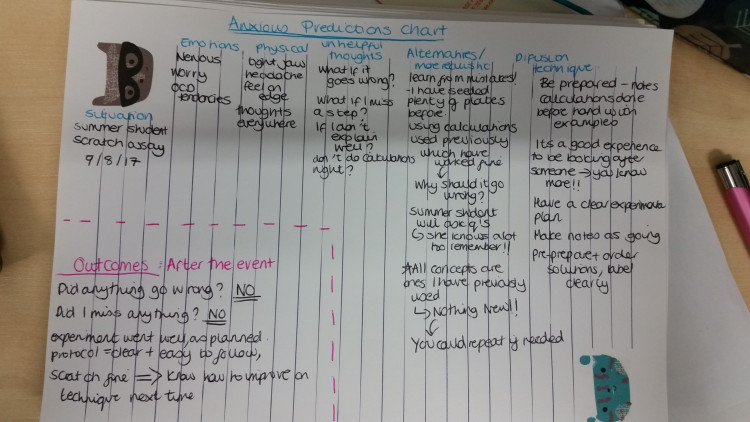The anxiety fights back, but I will persist

Anxiety ebbs and flows. One week you can feel super chilled, and the next, feel on the edge all of the time. This week I am on the edge.
So, what makes this week so different?
I have a very lovely summer student, who is helping me do a few experiments. We had decided that this week she would do a scratch wound assay. A scratch assay is actually a pretty easy experiment: you grow cells to confluency in a 24 well plate (our cells are Human Keratinocytes or HaCaT cells which replicate the top layer of skin), you make a scratch down the centre of the well, and take a photo of the scratch. You then monitor the wound healing over a 24hr period, and compare the overall ‘healing’ of each scratch. This is a great experimental method to test out different compounds and their overall effect on wound healing. It is a relatively fast experiment, and gives good data, which is easy to analyse and draw conclusions from.

Scratch when it has first been done
After 24 hours- the wound for this sample has completely healed
It is also an experiment that, until today, I had never done before- and I had to show someone who had never done it before, how to do it!
Realistically, this situation shouldn’t have stressed me in the slightest. I have read enough about the concepts of the experiment and the protocol to know what I needed to do and when; I had a detailed protocol I had written telling me stepwise what to do – what media I had to make, how much, and the order of the conditions in my plate. And yet, despite this, I could feel the tension in me, the muscles of my neck tensing, my jaw muscles tensing. And I started to notice the other ‘signs’ coming out too – my OCD-like tendencies increase when I am anxious. It is good as a scientist to check what you are doing, and make careful notes and tick charts, but when you start checking if the freezer door is closed 5/6/7 times, it starts getting out of hand.
So, I sat myself down, and made myself write out an anxious predictions chart, which did kind of help. I talked to my student, we had a good time (we did the experiment). Nothing went really super wrong. We had a few scratches which we couldn’t get a good photo of, as they were too wide to all be photographed on the microscope – but this happens. In the end, the experiment went as well as could be hoped. We now just have to wait until tomorrow to see the results – which will be really interesting.
I then went back to my anxious predictions chart – did any of these things come true?
No – oh, what a surprise!
I can see the stupidity of some of these anxious predictions written down. I can see what actually happened. I can see that my predictions and what happened are way out of line. But, at this moment in time, although I can see it, it’s like my brain isn’t accepting it. This is normal with CBT training though. You challenge your thoughts, write everything down, and write down what happened. Read it through. Realise what you thought would happen was wildly wrong, and most likely out of proportion of the event. It won’t make your anxious thoughts go away, straight away, but the more times you do this process, the more you challenge your thoughts, the more you will begin to accept the truths, and the less you will believe the anxious ones.
Now this experiment is done, my brain has turned to my next worry: my big experiment on Friday. So I will show you how I work through each worry, and challenge it.
The first worry – will my tissue sample come? I work with tissues from a separate institute, and we never know until the day, until about an hour before, if we will have tissue. This is something completely out of my hands – the tissue may come, it may not. If it doesn’t, whatever… I do this experiment next time.
The second worry: I have never done this experiment by myself. But, I have done it multiple times with a colleague. I have used all the techniques before. The only difference is I will be working alone – so it will take me longer. Really, this is not an issue.
As I sit here writing this blog, I can already feel some of my worries begin to subside. Putting things in perspective is a great thing to do – often you need to write it down for yourself to see.
I still have an extremely tight jaw, almost painfully so. I have most likely been grinding my teeth at night again- which is common when I start getting anxious. These prediction charts won’t relieve this straight away, but decreasing my overall stress levels will slowly lead to these symptoms being alleviated too. It’s like a headache. You have a massive headache, you take a tablet. The headache won’t go away, straight away, but in an hour or two you will realise it’s gone.
I am going to continue to work hard on reducing my anxiety – I am not going to challenge the OCD tendencies by ignoring the desire to check something for the umpteenth time. I will make more charts (I am getting good at them!), and I will do this biggest thing of all – make myself do what is causing me anxiety in the first place. Show myself that it wasn’t so bad. Show myself it was nothing to be worried about. Slowly it will improve. This week may not have been the best so far- but next week, it will be better.
Dr. Erica Hawkins (@ScientistErica) is a postdoctoral scientist working on starch synthesis in plants. This story was published on August 9, 2017, on Dr. Hawkins’ blog, ‘A scientist called Erica’ (available here), and has been republished here with her permission.






